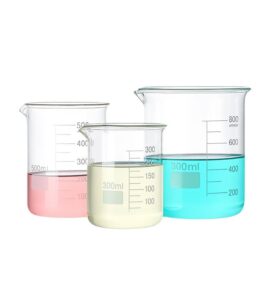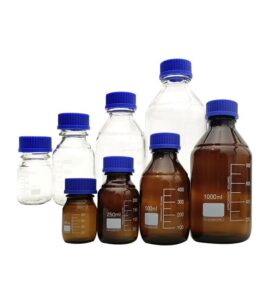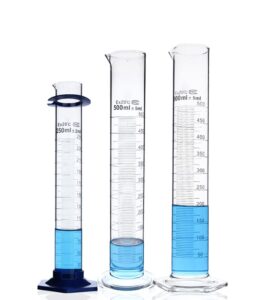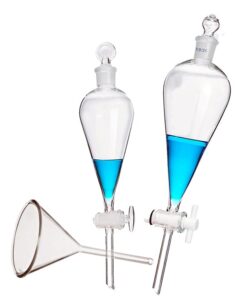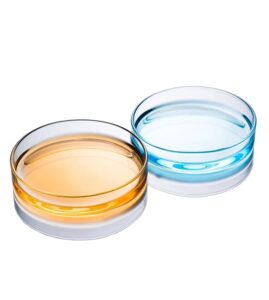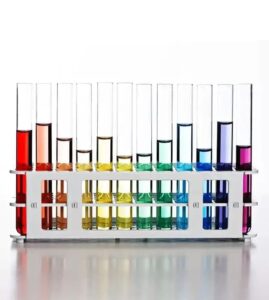Has it ever piqued your curiosity as you roamed through the corridors of a scientific laboratory, eyes alighting on a diverse range of oddly shaped vessels? Maybe you’ve wondered, why flat bottom flasks and round bottom flasks exist? Do their shapes serve a specific purpose?
To clarify, the main distinction between a flat bottom flask and a round bottom flask is their shape, which leads to differing applications within the laboratory setting.
Unveiling the Flat Bottom Flask
Flat bottom flasks, true to their name, feature a flat base. They can stand solo on a flat surface like a benchtop or a heating mantle without the necessity for added support. This convenient design makes them versatile tools for a spectrum of laboratory tasks.
Flat bottom flasks are the laboratory workhorses, involved in tasks that require moderate temperature conditions. They shine in roles that require dissolving substances into solutions, heating liquids, or culturing microbes.
The stability offered by a flat bottom flask is unmatched, with minimal risk of accidental toppling compared to other flask types. Coupled with an even heat distribution when placed on a heating mantle, they’re ideal for tasks that need consistent temperature conditions source.
The Round Bottom Flask Revealed
Opposed to the flat bottom flask is the round bottom flask, characterized by a curved, spherical bottom. This design means it requires a stand or a heating mantle to rest upon.
Round bottom flasks are most often employed for tasks requiring controlled temperature and pressure conditions, like distillation or chemical reactions.
Their design allows for even heating and stirring, which minimizes hotspots and facilitates controlled reactions. Plus, their shape makes cleaning easier and allows them to better withstand pressure changes, particularly useful in vacuum distillations source.
The Distinct Roles of Flat and Round Bottom Flasks
Flat bottom flasks excel in relatively straightforward laboratory tasks that don’t require intense heating or specialized equipment. These can range from dissolving solids into solutions or culturing microbes.
In contrast, round bottom flasks are more geared towards complex procedures involving boiling or distillation, or chemical reactions under precise temperature control.
For vacuum distillations, the round bottom flask’s inherent pressure resistance gives it the edge. Similarly, in synthetic chemistry, round bottom flasks often overshadow their flat bottom counterparts due to their capacity for intense heat and stirring.
More Than Just Flat and Round Bottom Flasks
Laboratories are home to a multitude of flasks beyond just flat and round bottom flasks. For instance, Erlenmeyer flasks offer a conical shape ideal for mixing contents without spilling, while volumetric flasks provide high precision for dilution tasks.
Picking the Right Flask for the Task
The choice between a flat bottom and a round bottom flask comes down to the specifics of the experiment at hand.
For high-temperature tasks, round bottom flasks reign supreme due to their design promoting even heating source. Similarly, for vacuum applications or vigorous
stirring, round bottom flasks hold the advantage.
Conversely, flat bottom flasks shine in procedures that involve simple reactions or dissolution at room temperature. Also, when stability is required, such as during titrations or culturing tasks, the flat bottom flask is the clear choice source.
Additional Factors to Consider
Beyond the nature of the experiment, there are also other factors that might influence the choice of flask in a laboratory setup.
For instance, safety considerations can play a significant role. Round bottom flasks, due to their curved structure, can better withstand changes in pressure and are thus generally safer for reactions that involve gases or operate under vacuum conditions source.
Efficiency of heating is another aspect to consider. When heated, round bottom flasks offer uniform heat distribution, which prevents the formation of hot spots and allows for more controlled reactions.
Finally, cleaning convenience can also come into play. Round bottom flasks are often easier to clean due to their shape, which is particularly beneficial in scenarios where cleanliness and contamination prevention are critical.
Exploring The Larger World of Flasks
The flat bottom and round bottom flasks are just the tip of the iceberg when it comes to laboratory flasks. Other types, such as the conical-shaped Erlenmeyer flasks or the precise volumetric flasks, have their specific roles in the lab.
These flasks underscore the diversity of laboratory equipment and the ingenuity of scientific design – where each shape and form serves a unique purpose that ultimately contributes to the advancement of scientific knowledge.
Final Words
So there you have it, the mystery behind the shapes of the humble laboratory flasks unveiled!
The flat bottom flask, with its stability and versatility, proves to be the jack of all trades in simpler lab procedures. The round bottom flask, on the other hand, takes the spotlight in more complex laboratory operations, its unique shape providing superior control in heating and stirring.
In the grand scheme of things, understanding the roles and applications of these tools helps scientists conduct their experiments more efficiently and safely. In the world of science, no detail is too small – even the shape of the flasks matters! After all, great science is as much about the right ideas as it is about using the right tools.


